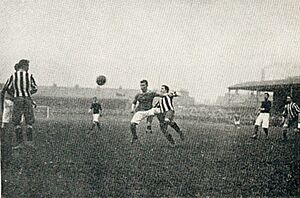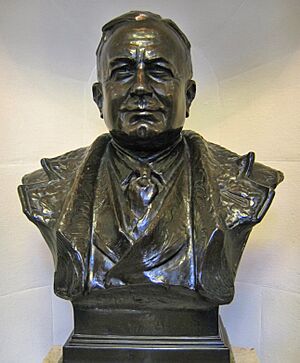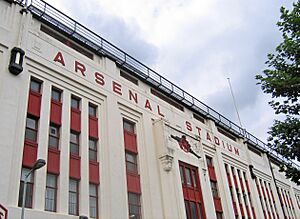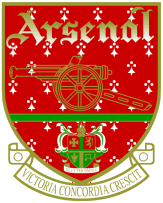History of Arsenal F.C. (1886–1966) facts for kids
The history of Arsenal Football Club from 1886 to 1966 tells the story of the club from its very beginning. This period includes Arsenal's first two big successes: winning many trophies in the 1930s, and then again in the late 1940s and early 1950s. It also covers a time when the club wasn't doing so well in the early 1960s.

Arsenal Football Club started in 1886. It was formed by workers from a factory in Woolwich, which was then in Kent. These workers made weapons. In 1891, the club decided to become professional, meaning players were paid. Two years later, they joined The Football League. They moved up to the top division, called the First Division, in 1904.
However, by 1910, the club had money problems. A group of businessmen bought the club. The main new owner, Sir Henry Norris, helped the club financially. He also moved the team to a new stadium in Highbury, north London, in 1913. This stadium was called Arsenal Stadium. After the First World War, in 1919, Arsenal was voted into the First Division again. They have stayed in the top division ever since!
Arsenal didn't have major success until Herbert Chapman became their manager in 1925. Chapman changed how the club trained and played. Under him and his next manager, George Allison (who took over after Chapman passed away in 1934), Arsenal won five First Division titles and two FA Cups in the 1930s.
After the Second World War, Tom Whittaker continued this success. He led the club to two more First Division titles and another FA Cup. But after Whittaker died, Arsenal's performance slowly went down. By 1966, they were often finishing in the middle of the league table. They hadn't won a trophy in thirteen years. This led to the manager, Billy Wright, being replaced by Bertie Mee in 1966.
Contents
Starting Out (1886–1910)
The club began as Dial Square Football Club in 1886. It was started by workers from the Dial Square workshop at the Royal Arsenal factory in Woolwich. They were led by David Danskin, who bought the club's first football, and Jack Humble. One of the players, Fred Beardsley, used to play for Nottingham Forest. He helped the team get their famous red kits from his old club.
Dial Square played their first game on December 11, 1886, winning 6–0. The club soon changed its name to Royal Arsenal. They played on Plumstead Common at first, then moved to the Sportsman Ground, and later to the Manor Ground. They also played at the Invicta Ground for a short time, but it was too expensive.
During these early years, Royal Arsenal won some local trophies. They won the Kent Senior Cup and London Charity Cup in 1890, and the London Senior Cup in 1891. They also entered the FA Cup for the first time in 1889. Soon, it became clear that professional teams from northern England were much stronger. Arsenal's amateur players were being offered money to join other clubs.
In 1891, Royal Arsenal decided to become professional. Many amateur clubs in the south didn't like this. The club was banned from local competitions. To keep playing, they changed their name to Woolwich Arsenal in 1893. They were then invited to join the Football League, starting in the Second Division. This made them the first southern club in the League. Some amateur players left to form a new team, Royal Ordnance Factories.
Woolwich Arsenal played in the Second Division for eleven seasons. They were usually in the middle of the table. In 1899, Harry Bradshaw became manager. He signed new players, like goalkeeper Jimmy Ashcroft. Arsenal then won promotion to the First Division in the 1903–04 season.
Even though they did well in the FA Cup, reaching the semi-finals in 1906 and 1907, Arsenal struggled in the First Division. They only finished above tenth place twice between 1904 and 1913. The club had money problems. Their stadium was in Plumstead, which didn't have many people living nearby. This meant fewer fans came to games, and the club earned less money. To survive, Woolwich Arsenal had to sell their best players. Crowds got smaller, and the club was close to going bankrupt. In 1910, a businessman named Sir Henry Norris bought the club.
Moving to Highbury (1910–1925)
Sir Henry Norris knew that Woolwich Arsenal needed more money. He decided to move the club to Highbury, in north London. Many fans in Woolwich and people in Highbury didn't like the idea. But Norris went ahead, spending a lot of money to build the new stadium.
Woolwich Arsenal moved to Highbury in 1913. They had just finished last and were relegated to the Second Division. In 1914, the club changed its name to "The Arsenal," and then simply "Arsenal" in 1919. The move to Highbury brought many more fans. The average attendance jumped from 11,000 to 23,000. This helped the club avoid financial ruin.
In 1919, after the First World War, Arsenal controversially rejoined the First Division. They had only finished sixth in the last season before the war. The First Division was being expanded, and clubs had to vote on who would join. Sir Henry Norris argued that Arsenal should be promoted because they were the first League club from the South. The League agreed, and Arsenal got more votes than other teams, including Tottenham Hotspur. This decision made the rivalry between Arsenal and Tottenham very strong.
Some people thought Sir Henry Norris might have made special deals to get Arsenal promoted. He later resigned from the club in 1929 after being found to have misused his expenses account. Regardless of how it happened, Arsenal has stayed in the top division since 1919, which is a record in English football.
Arsenal's return to the First Division wasn't immediately successful. Under manager Leslie Knighton, the club never finished higher than ninth. In the 1923–24 season, they almost went back down to the Second Division. Norris fired Knighton in May 1925 and hired Herbert Chapman, who was managing Huddersfield Town.
The Chapman Era (1925–1934)

Herbert Chapman brought many changes to Arsenal. He improved training and player care. He also added numbers to players' shirts in 1928 and changed the team's colours, adding white sleeves to the red shirt in 1933. Chapman also asked journalists to call the club just "Arsenal" and helped rename the local Tube station to Arsenal.
Chapman had a lot of money to spend on new players because Arsenal's income had grown from the new stadium. This led to Arsenal being called the "Bank of England club" because they spent so much. Chapman's first big signing was Charlie Buchan. After a big loss to Newcastle United, Buchan suggested a new way of playing, called the "WM" formation. This made the defence stronger. Chapman improved this formation, focusing on fast attackers and creative midfielders.
Arsenal finished second in Chapman's first season, which was their best finish at the time. Over the next few seasons, Chapman built his team, signing players like Joe Hulme, Jack Lambert, Tom Parker, and Herbie Roberts.
In 1926–27, Arsenal reached their first FA Cup final but lost 1–0 to Cardiff City. It was the only time a non-English club won the FA Cup. Chapman kept building his team, signing future captain Eddie Hapgood, and great attackers like David Jack, Alex James, and Cliff Bastin. Alex James, a creative midfielder, became the key player for the team.
Three years later, in 1929–30, Arsenal reached the FA Cup final again. They played against Chapman's old club, Huddersfield Town. Arsenal won 2–0 with goals from James and Lambert. This was the club's first major trophy.
Arsenal then became the strongest club in England. They won the First Division for the first time in 1930–31. Arsenal scored many goals that season, including 7–1, 7–2, and 9–1 wins. They finished as champions, scoring a club record 127 league goals.

The next season, 1931–32, Arsenal reached the FA Cup final again. They lost controversially to Newcastle United. Arsenal was leading 1–0, but Newcastle's equalizing goal came after the ball seemed to go out of play. Newcastle scored again to win 2–1. Arsenal also finished second in the League that season.
Arsenal bounced back in 1932–33, winning their second League title. They had a slow start but then went on a long winning streak. They beat Aston Villa 5–0 at Highbury to win the title. Chapman started bringing in younger players like George Male and Ray Bowden. However, the team lost to Walsall from a lower division in the FA Cup, which was a big upset.
Three League Titles in a Row (1934–1939)
Arsenal started the 1933–34 season well. But in January 1934, Herbert Chapman sadly died suddenly from pneumonia. Even without him, under temporary manager Joe Shaw, Arsenal still won the League title that season.

George Allison became the new manager in 1934. He signed new players like Jack Crayston, Wilf Copping, and striker Ted Drake. With these new players, Allison led Arsenal to win a third League title in a row in 1934–35. Arsenal was scoring many goals again. Ted Drake scored a club record 42 league goals that season. Arsenal had huge wins, like 7–0, 8–1, and two 8–0 victories.
Arsenal's success meant more and more fans came to games. Their home stadium, Highbury, was completely rebuilt. The old stands were replaced with modern ones. The new stadium saw its biggest crowd ever, 73,295 people, on March 9, 1935, for a match against Sunderland. Arsenal won a second FA Cup in 1935–36, beating Sheffield United 1–0 in the final. They also won a fifth League title in 1937–38. This was a very successful decade for the club.
Second World War (1939–1945)
When the Second World War started in 1939, all professional football in Britain stopped. Highbury stadium was used as a place for air raid precautions. During the war, a bomb hit the North Bank stand, damaging the roof. Because Highbury was closed, Arsenal played their home games at White Hart Lane, the stadium of their rivals, Tottenham Hotspur.
Wartime matches don't count in official records. Many footballers joined the armed forces. Arsenal won the Football League War Cup South in 1943 and the Football League (South) titles in 1940, 1942, and 1943.
In November 1945, Arsenal played a friendly match against a team from Dynamo Moscow from Russia. Many Arsenal players were still away serving in the war. So, Arsenal used six guest players, including famous ones like Stanley Matthews. The match was played in thick fog, and Dynamo won 4–3. There were many different stories about what happened during the game, but it showed how competitive sports can be.
After the War (1945–1966)
The war had a big impact on Arsenal. Nine players died, and many others had their careers cut short. The club also had debts from building Highbury and repairing war damage. When football started again in 1946, Arsenal struggled. They finished 13th in 1946–47, their worst finish in 17 years.
Manager George Allison retired and was replaced by his assistant, Tom Whittaker. Whittaker had immediate success. He won the League title in the 1947–48 season. Led by captain Joe Mercer and goals from Reg Lewis and Ronnie Rooke, Arsenal stayed at the top of the table and won by seven points. However, many of the players were getting older. Whittaker brought in younger players like Doug Lishman and Cliff Holton. With these new players, Arsenal won the FA Cup in 1949–50, beating Liverpool 2–0 in the final.
In the 1951–52 season, Arsenal almost won both the League and the FA Cup. But injuries and many postponed games meant they had to play ten matches in one month. They lost their last two games, including the title decider against Manchester United. A week later, Arsenal played Newcastle United in the 1952 FA Cup Final. Many players were still injured. Arsenal ended up with only seven fully fit players on the pitch, and Newcastle won 1–0.
Arsenal won their seventh League title in the 1952–53 season. It was a very close race, and they won by a tiny difference in goal average. This was Arsenal's last trophy for 17 years. The club's performance started to decline, especially after Tom Whittaker died unexpectedly in October 1956. Arsenal found it hard to attract top players, and some good young players left for more successful clubs.
Former players Jack Crayston and George Swindin became managers after Whittaker, but they couldn't bring back the success. Arsenal usually finished in the middle of the table. They also didn't do well in the FA Cup, not getting past the quarter-finals until 1971. Their rivals, Tottenham Hotspur, even won both the League and FA Cup in 1960–61.
In 1962, Arsenal hired Billy Wright, a famous former England captain, as manager. He didn't have much experience managing, and he wasn't very successful. However, under him, Arsenal played in a European competition for the first time in 1963–64. In his final season, Arsenal finished 14th, their lowest position in 36 years. They also had their lowest attendance at Highbury, with only 4,554 fans at a match in May 1966. Billy Wright was replaced by the club's physiotherapist, Bertie Mee, in the summer of 1966.
|




